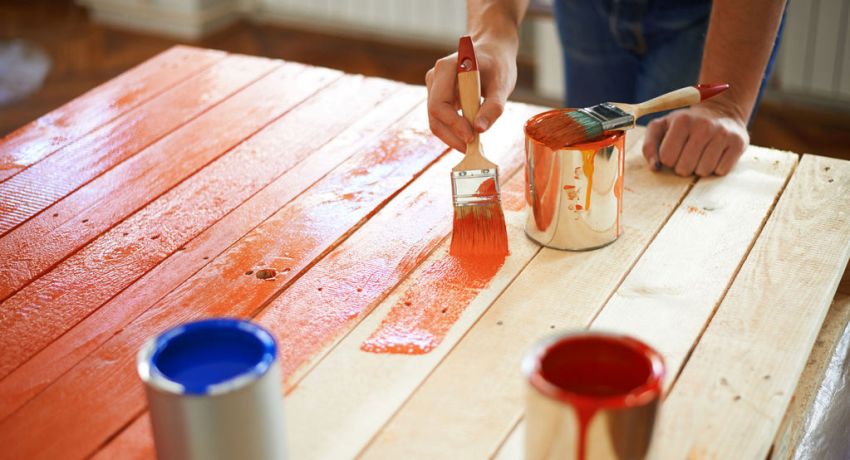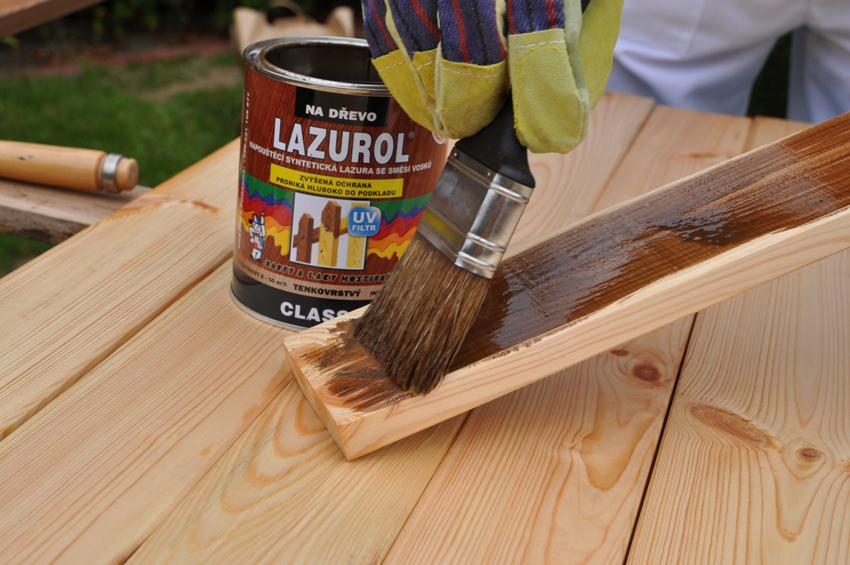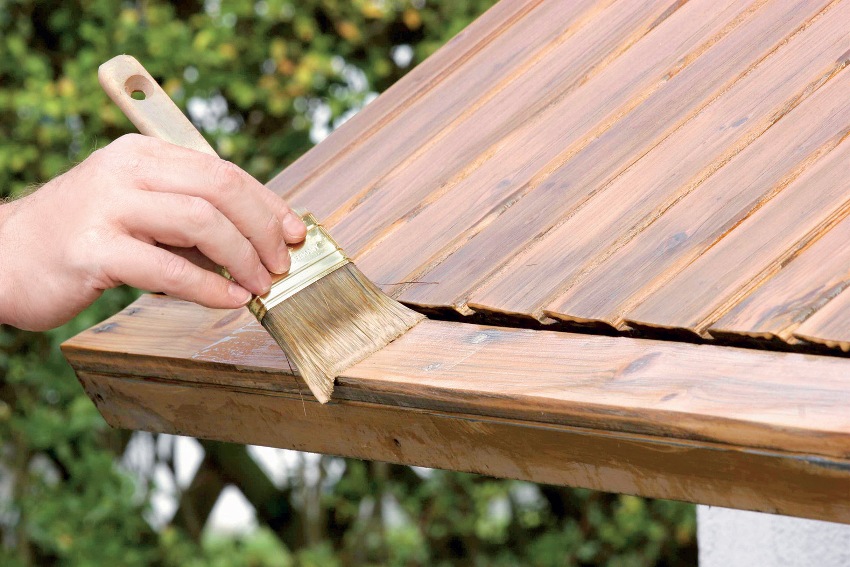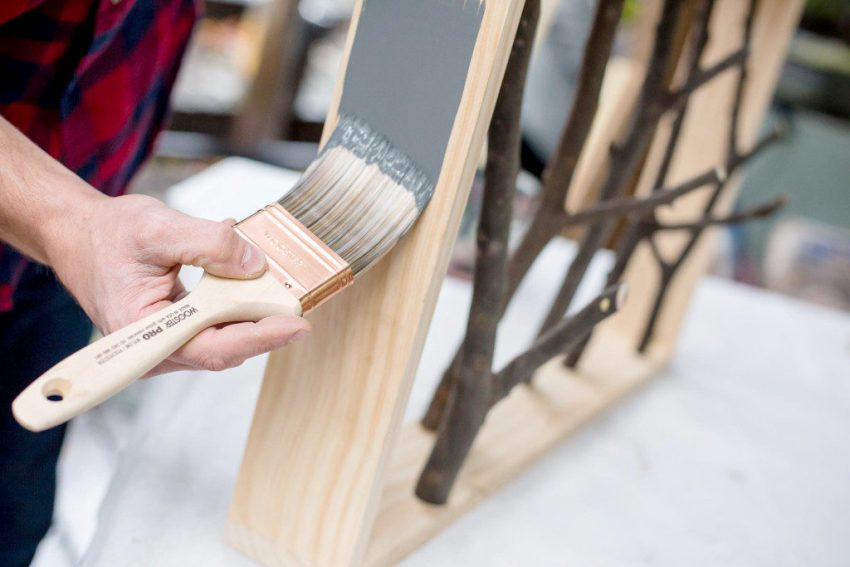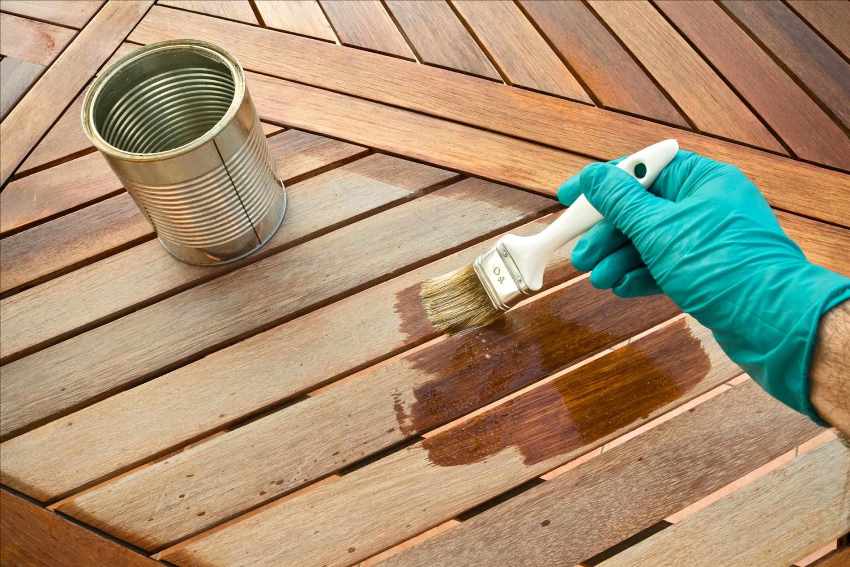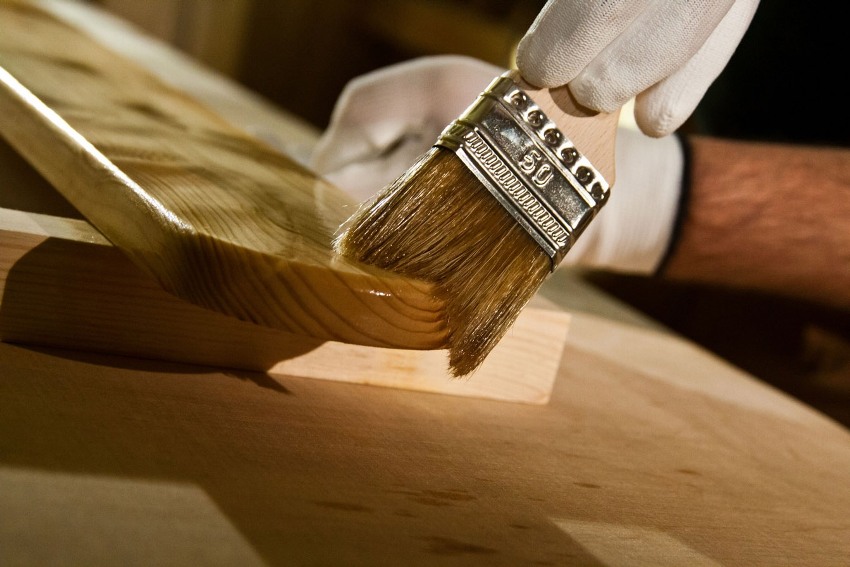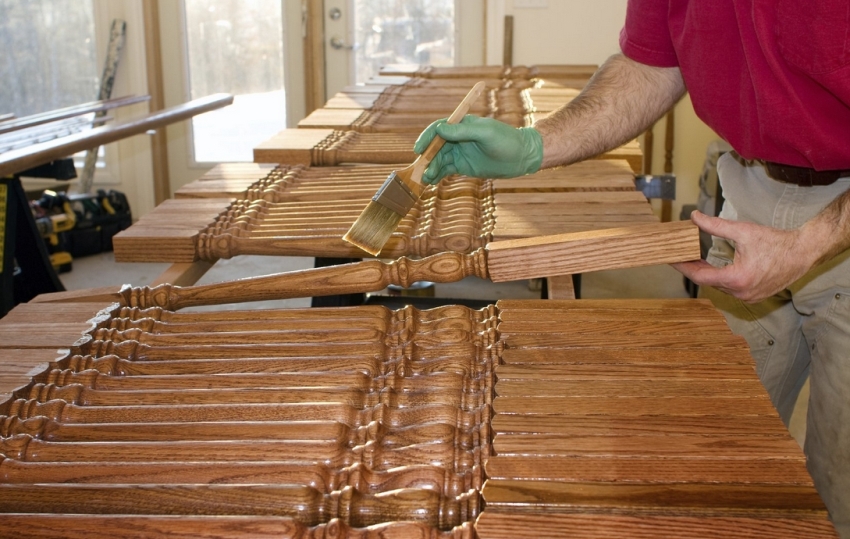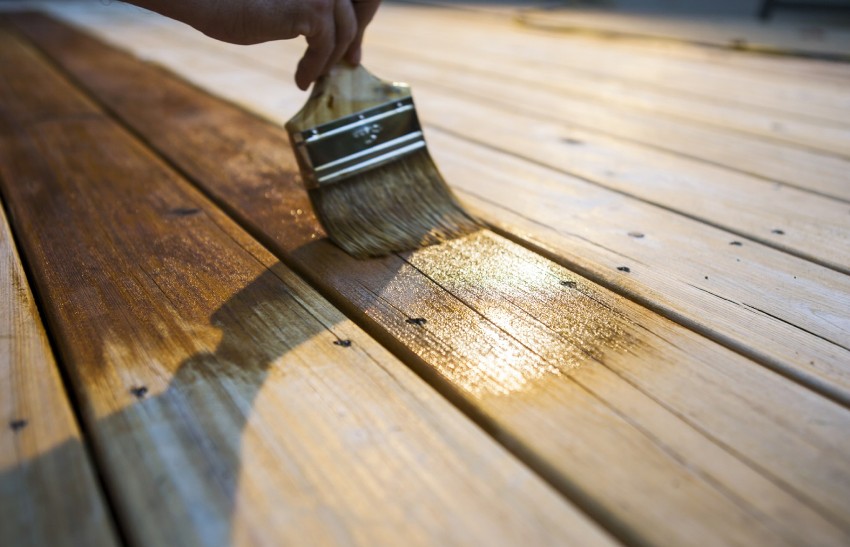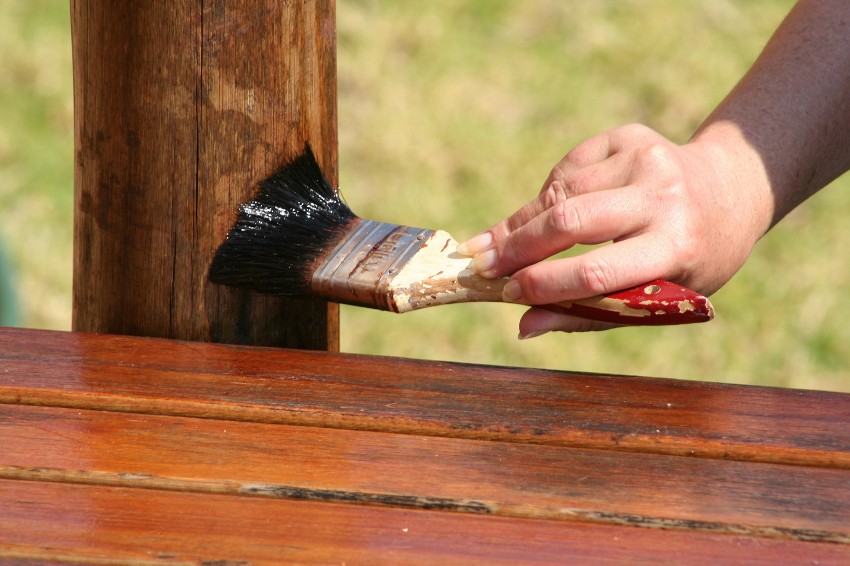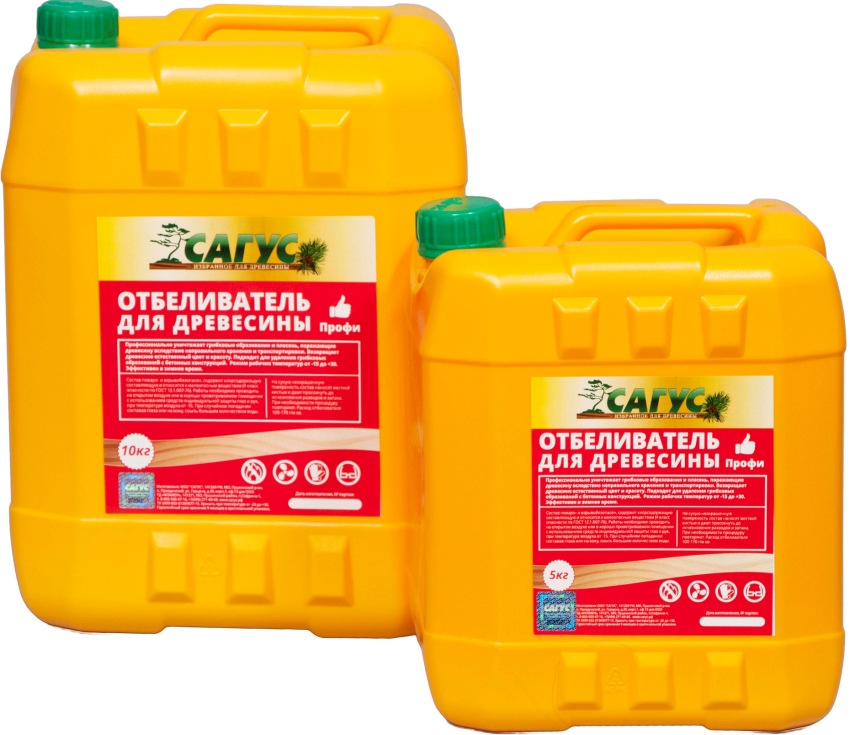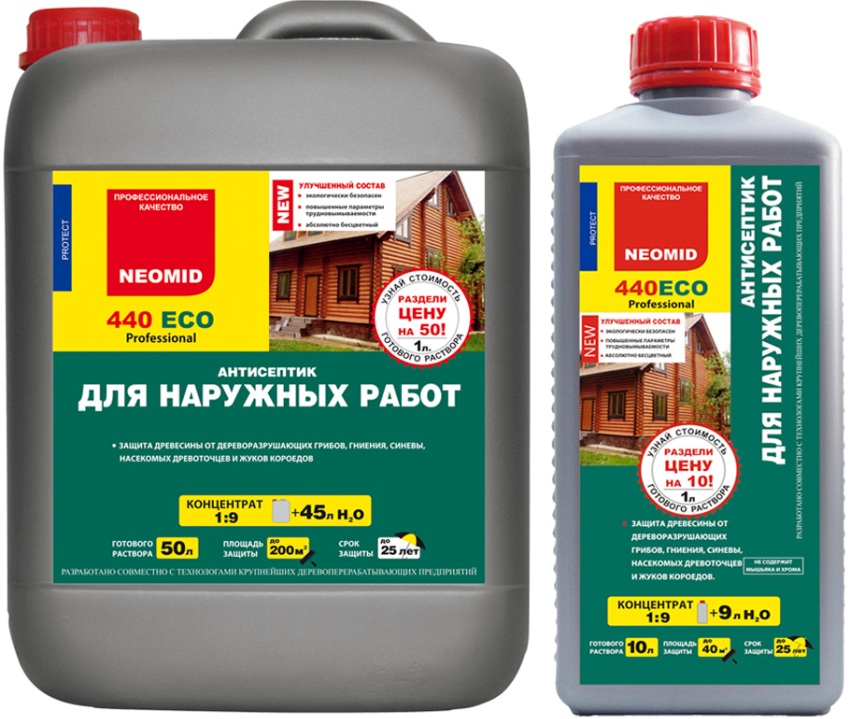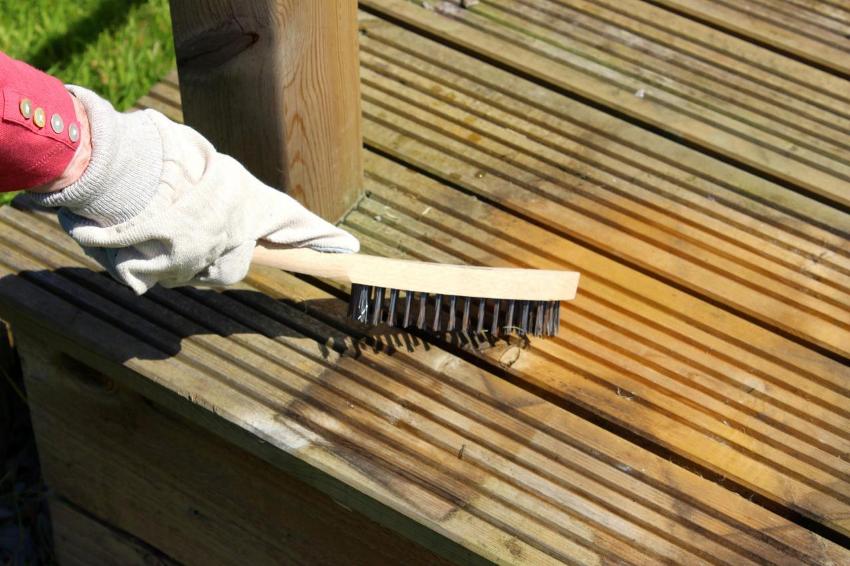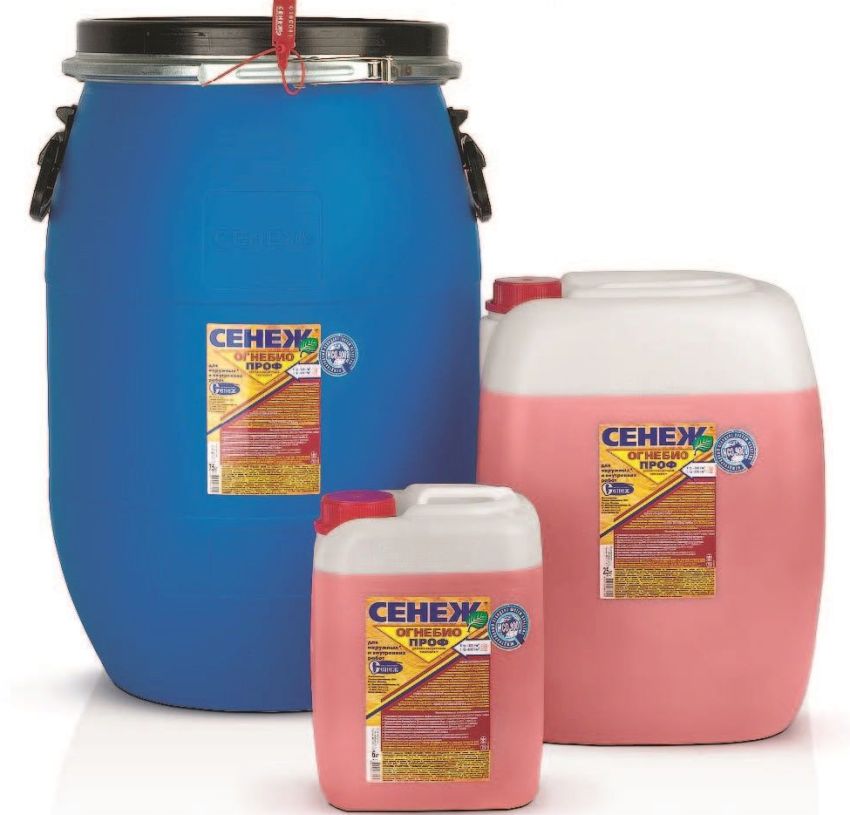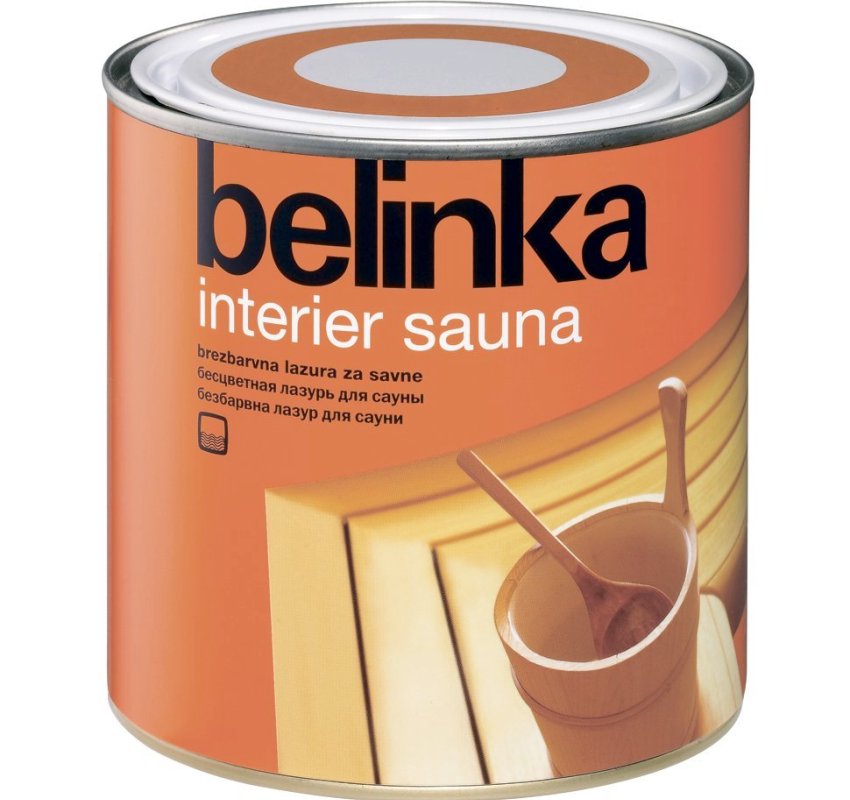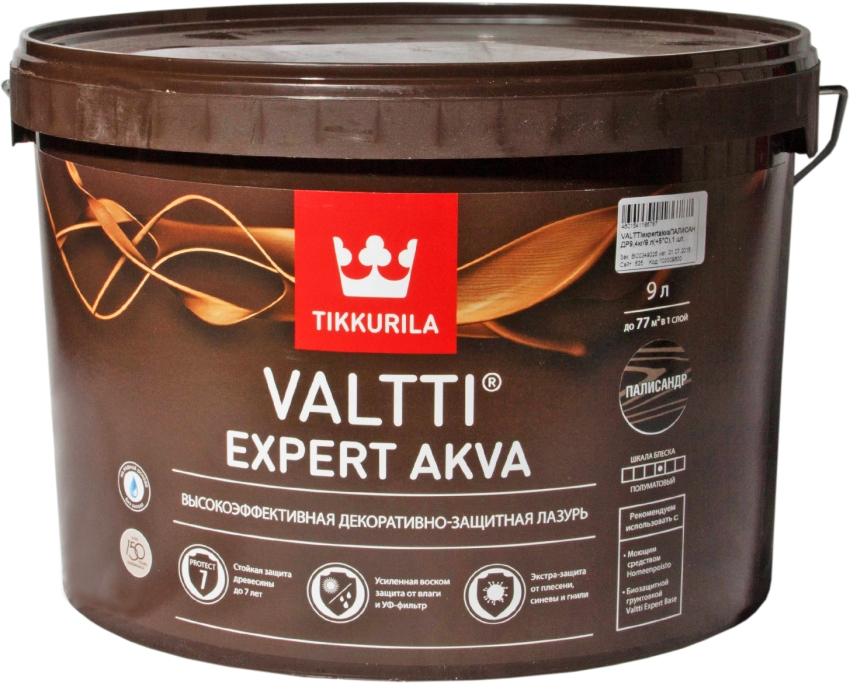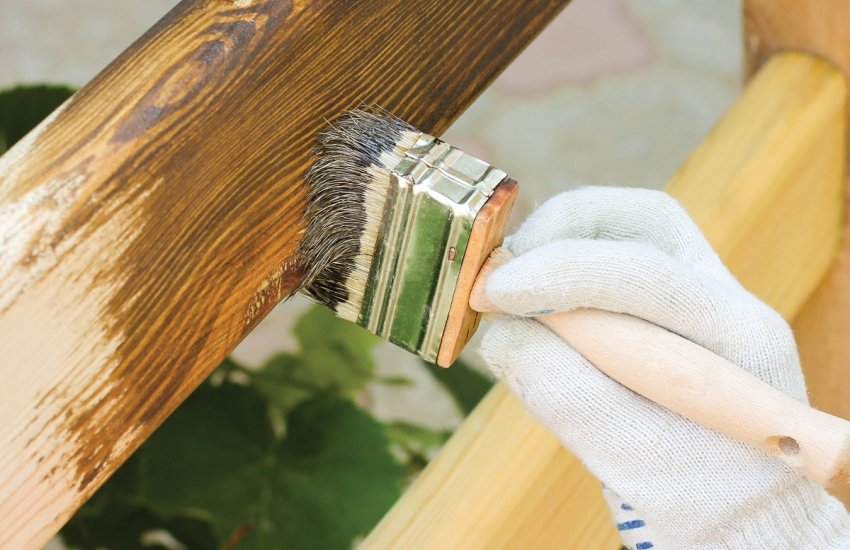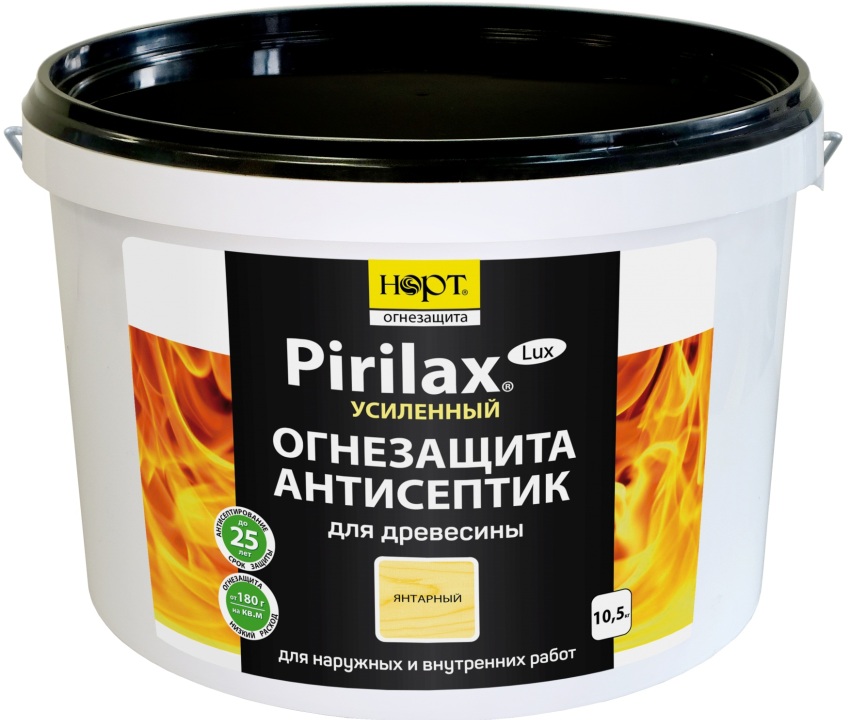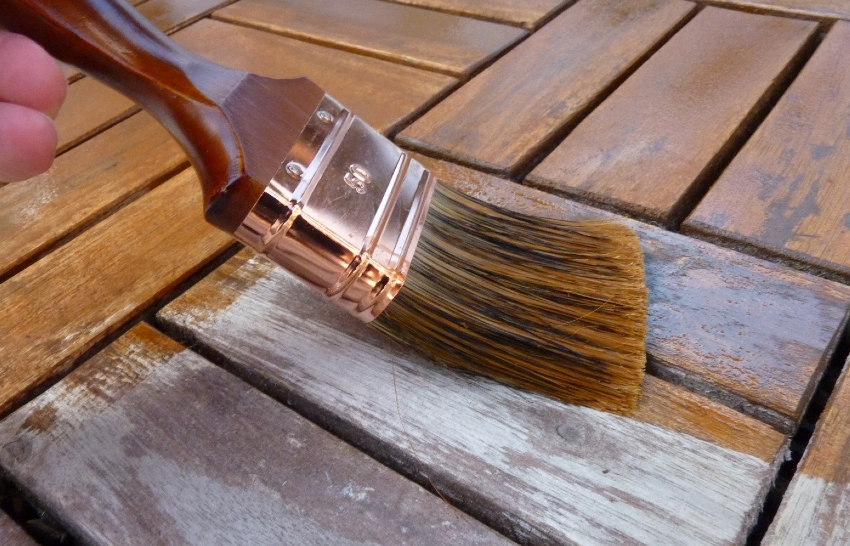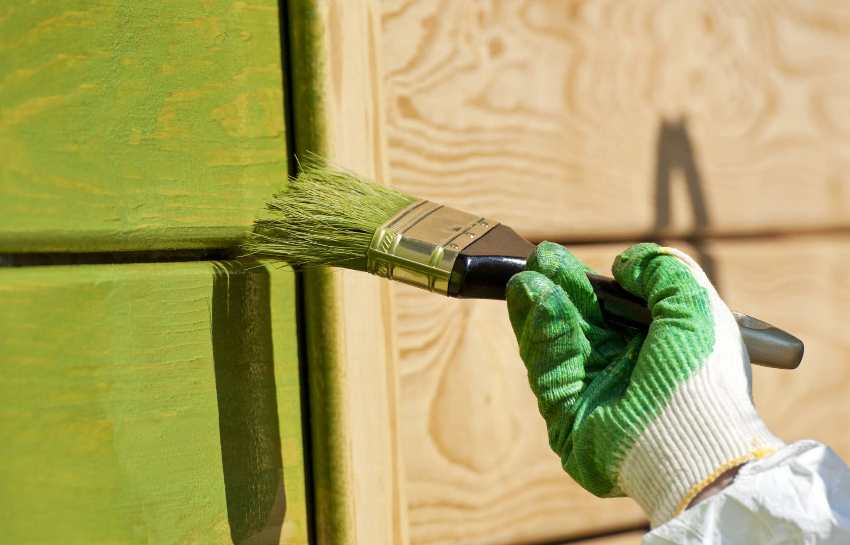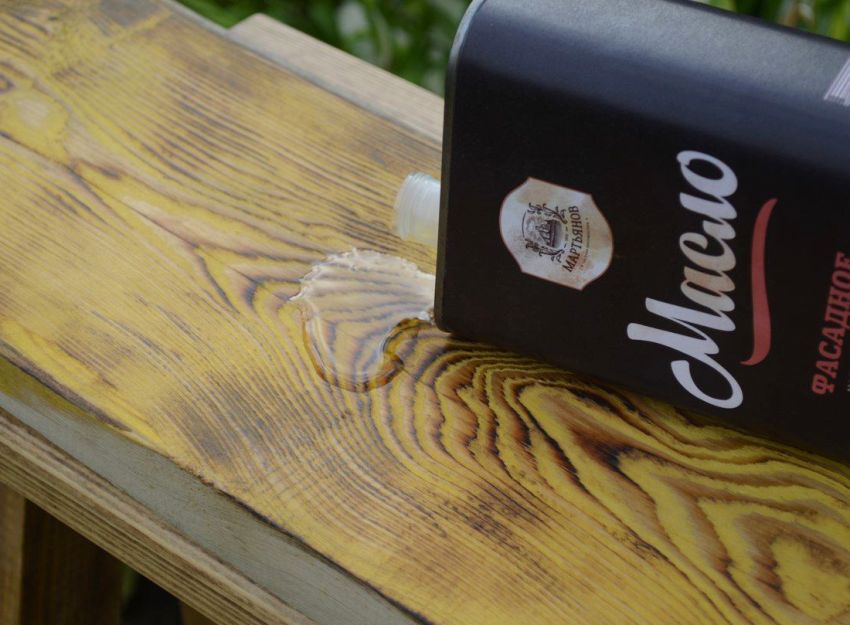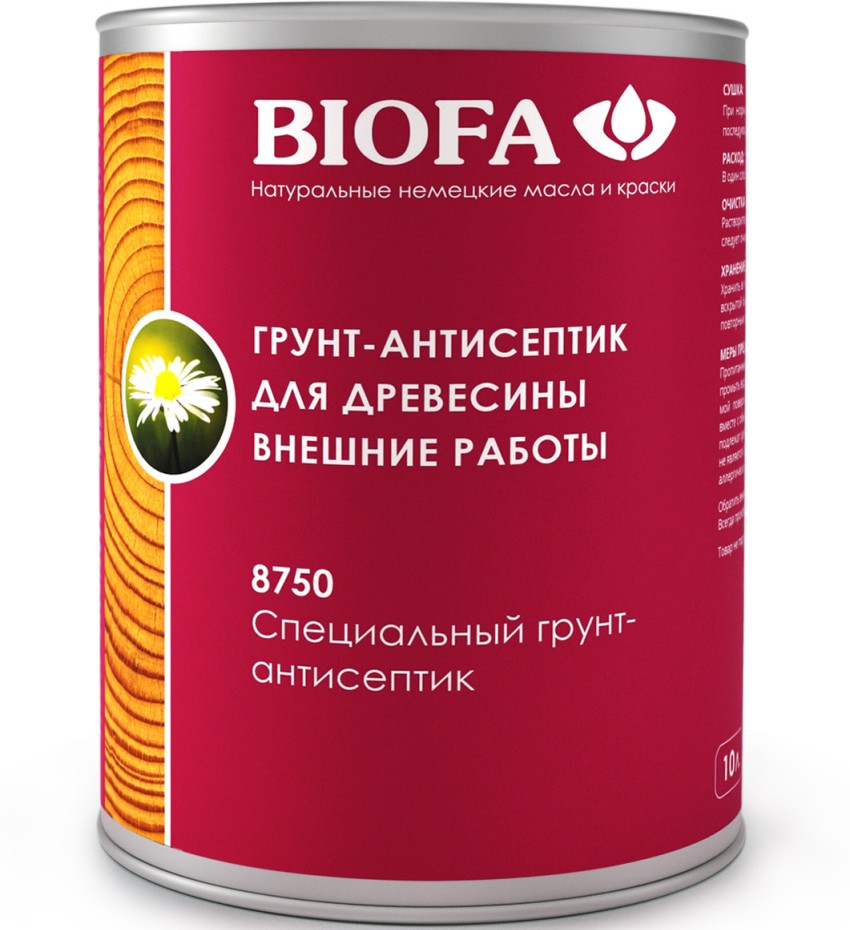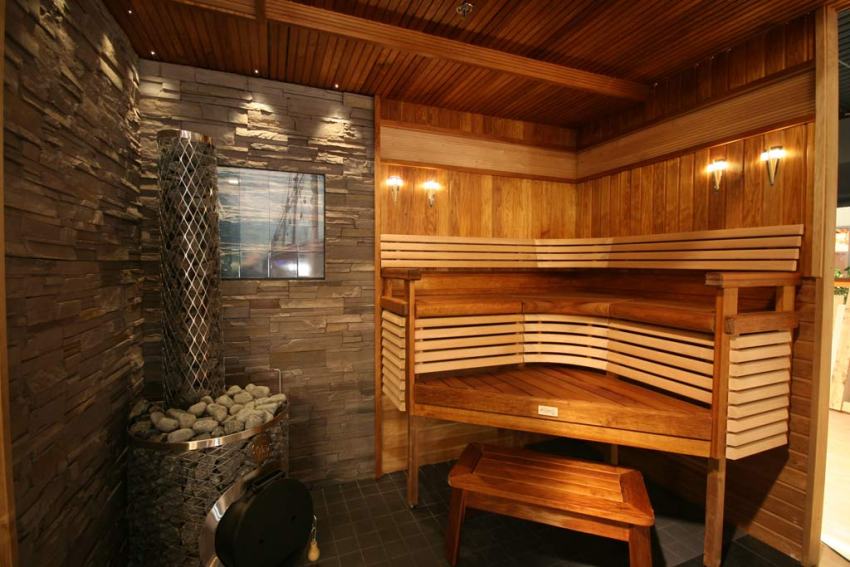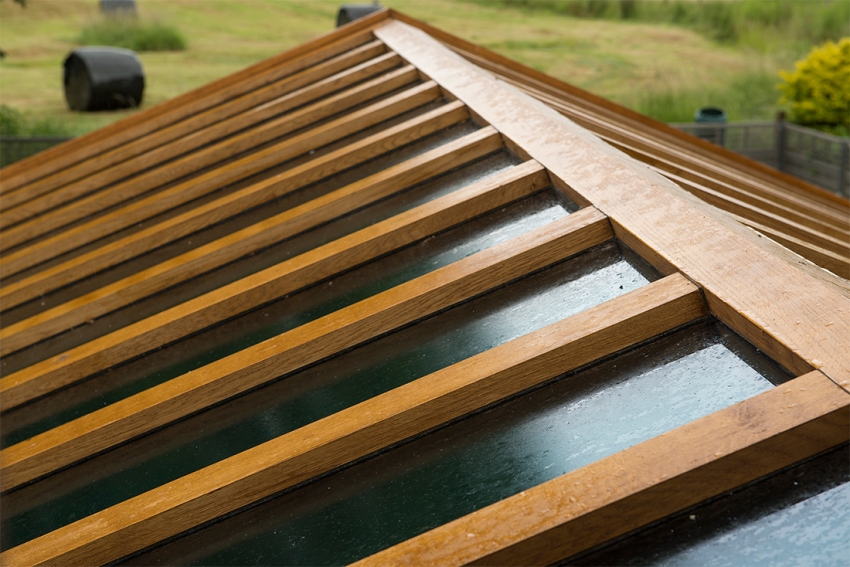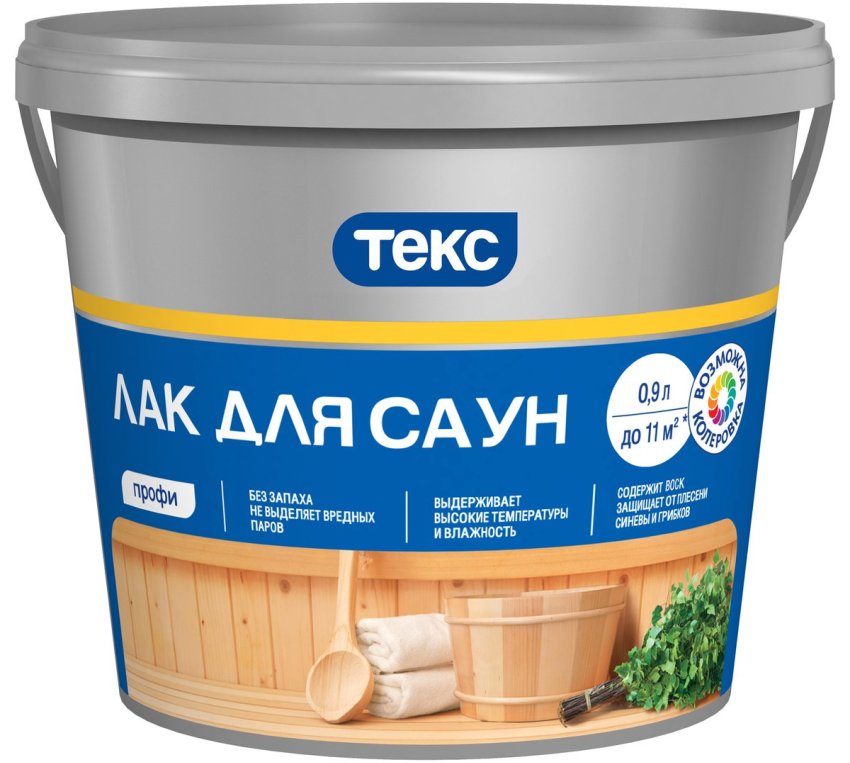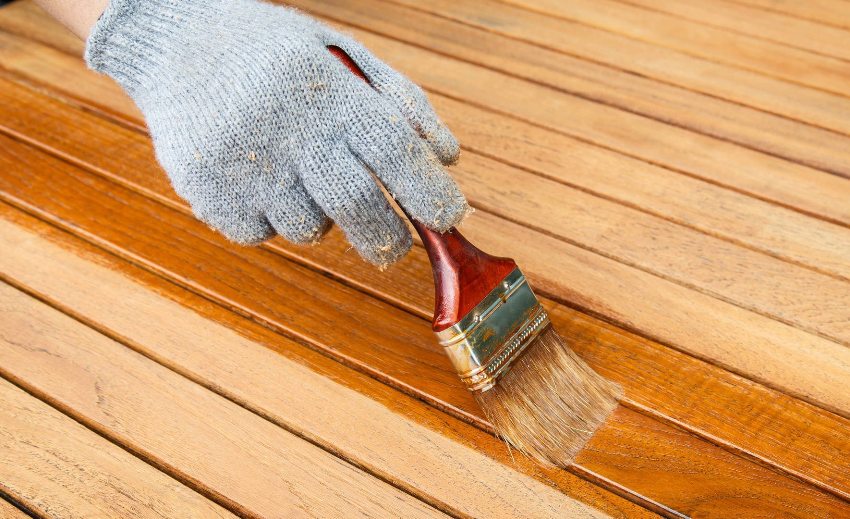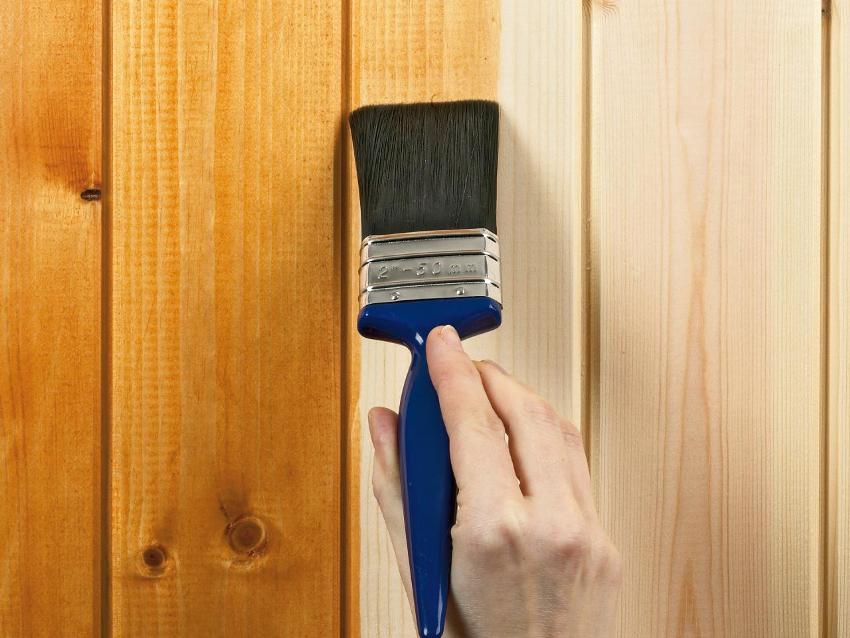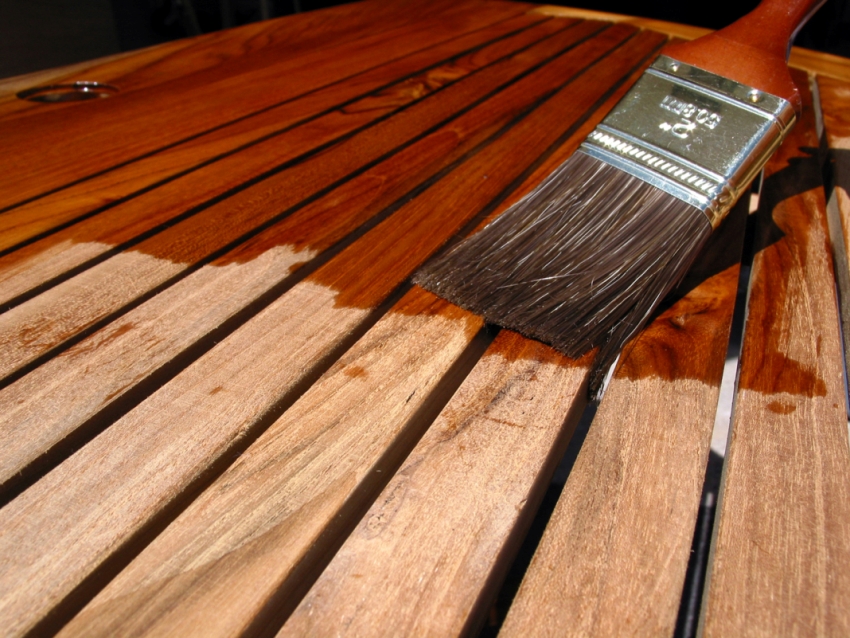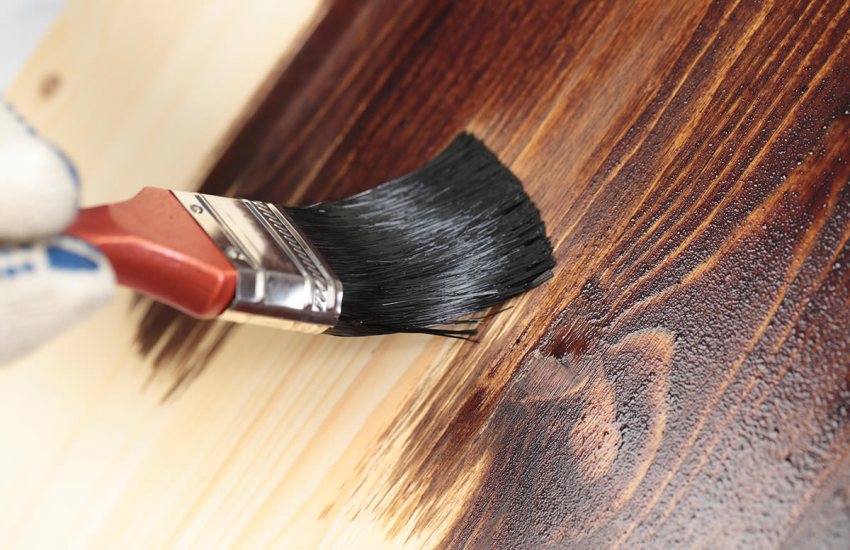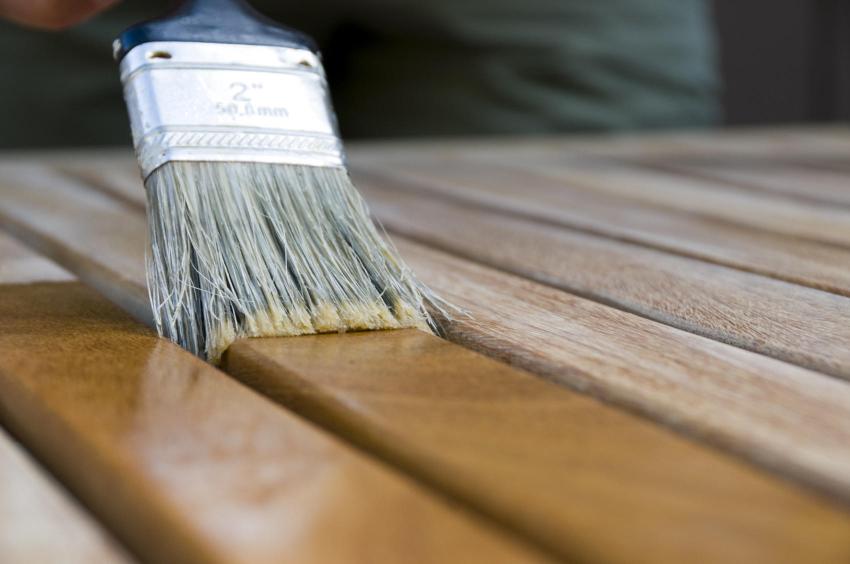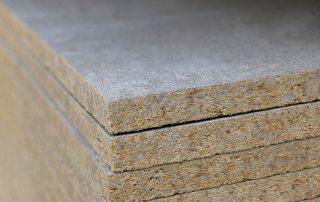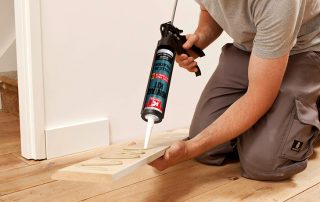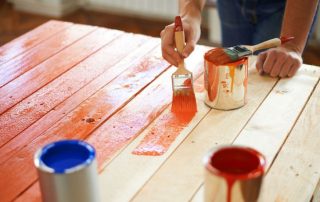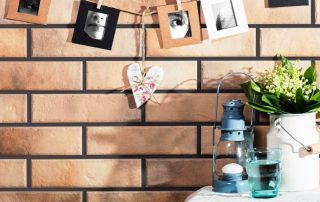Antiseptic for wood for indoor and outdoor work effectively protects the material from the negative effects of destructive factors. This article examines in detail the existing types of antiseptic agents, taking into account their properties and purpose. In the text, you can find basic recommendations for choosing high-quality formulations with optimal characteristics, as well as formulations that allow you to prepare a protective impregnation at home.
Content [Hide]
- 1 What is an antiseptic and its purpose: general information about the compositions
- 2 Which is better to buy a wood preservative: classification of compositions
- 2.1 Advantages and disadvantages of water based wood preservatives for outdoor use
- 2.2 Properties of non-washable wood preservatives: advantages and disadvantages of oil mixtures
- 2.3 Organic and combined wood preservatives for outdoor use
- 2.4 Characteristics of wood preservatives for interior use
- 2.5 Features of therapeutic and prophylactic antiseptics
- 2.6 Specificity of deep penetration wood preservatives and surface formulations
- 3 Which is better to choose a wood preservative: the functional purpose of the compositions
- 3.1 Protective antiseptics for bleaching wood
- 3.2 Whitening antiseptic concentrates for wood: Neomid and Prosept
- 3.3 Protective antiseptics against mold and other parasites
- 3.4 Antiseptics against parasitic microflora and fauna: PAF-LST and Senezh-BIO
- 3.5 Remedies for parasitic microflora and fauna: antiseptics for Tikkurila and Belinka trees
- 3.6 Wood preservative for fire protection: the main types of fire retardants
- 3.7 Means of fire-biological protection: antiseptics for the tree Neomid, Senezh and Pirilax
- 3.8 Which is better to use: tinting or glazing wood preservatives
- 3.9 UV protective agents: antiseptics for the Martyanov tree, Senezh and Biofa
- 3.10 Waterproof wood preservatives for outdoor use: Tikkurila and Pinotex
- 3.11 Moisture protection products for baths and saunas: antiseptics for wood Senezh and KRASULA
- 3.12 The best antiseptics for wood with high levels of natural moisture
- 3.13 Protective antiseptic for wood: which one is better to choose a composition for the end of the logs
- 4 Choosing a high-quality antiseptic for wood: reviews, prices and recommendations
- 5 How to make a wood preservative: impregnating the material with a protective agent
What is an antiseptic and its purpose: general information about the compositions
Wood has a large number of advantages, it is affordable, easy to handle and environmentally friendly. Therefore, this material is widely used for the construction of residential buildings and other structures. Wood consists of two components: lignin and cellulose.
Cellulose is a polymeric material with a linear structure. In turn, lignin has a more complex structure, it is multidimensional. The presence of cellulose gives wood flexibility, and lignin gives it high strength.
During the construction of a wooden building, do not forget that living material is used in the work, which completely depends on the external influence of such criteria:
- atmospheric factors (temperature changes, humidity, exposure to direct sunlight);
- biological factors (mold, fungi and bacteria, rodents and insects).
Antiseptic agents can reduce the negative impact of the biological environment and extend the life of the wood.
Why is it necessary to process wood with an antiseptic
In a felled tree, the fibers die off, on which saprophytes (fungi) begin to feed. They use special enzymes to convert organic compounds into minerals. Saprophytes cannot develop without a certain temperature, water, oxygen and nutrients. Fungi of this type are wood-destroying and wood-coloring.
Wood-coloring saprophytes develop exclusively on wood with a natural moisture level. They are concentrated mainly in the sapwood part of the material, only in rare cases penetrating into the core.
In the course of their vital activity, such fungi cause changes in the color of wood, giving it different shades:
- red;
- yellow;
- blue;
- green.
Wood-coloring saprophytes die under the influence of temperatures above 80 ° C. They are not able to destroy lignin, therefore, they do not affect the strength characteristics of wood, although they can mask the presence of rot.
Note! If the tree has an ugly shade, this indicates that the storage and transportation of lumber has been violated.
On the other hand, the presence of wood-staining fungi indicates that the material may be contaminated with wood-decaying agents that can spoil the material. Therefore, in the preparation process, the raw material is thoroughly dried, subjected to high temperature processing, as well as antiseptic agents.
In addition to fungi, wood can settle:
- seaweed;
- bacteria;
- insects.
Algae can only spoil the appearance of the material, while bacteria cause its destruction, provoking putrefactive processes. Many microorganisms and insects can cause serious damage to wood. Termites, grinders, bark beetles and woodcutters are especially dangerous. Antiseptics, of which there are many in the assortment of modern stores, struggle with all these problems.
Features and benefits of wood processing products
Antiseptic is a special composition that impregnates wood, giving it additional properties. It protects the material from mold, mildew, blue stain and microorganisms that feed on cellulose.
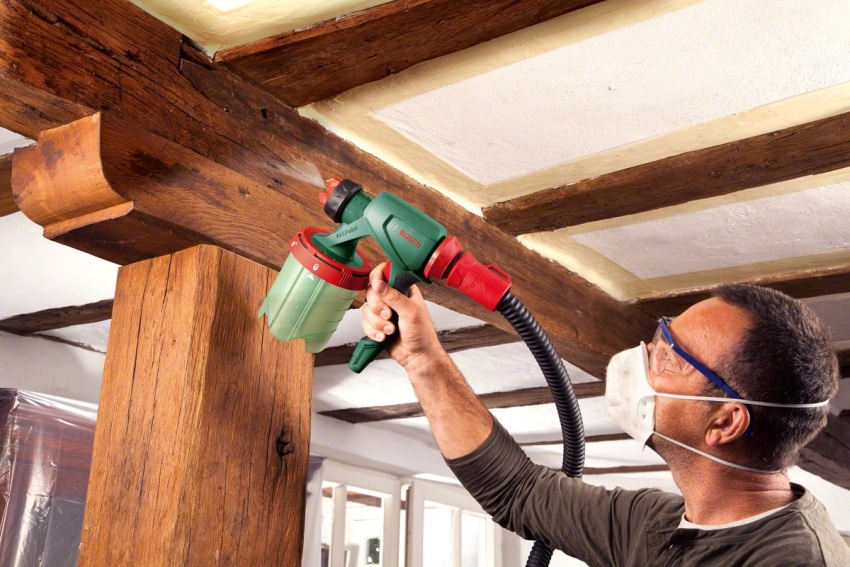
Antiseptic solutions contain oxidants and fungicides in their entire composition, therefore, when treating surfaces, it is necessary to use personal protective equipment for the respiratory tract
Modern antiseptic agents contain active substances:
- Oxidants - destroy saprophytic cells.
- Fungicides - present in the composition as compounds of organic and inorganic origin (copper, heavy metal salts, industrial phenols).
Fungicides block the action of enzymes secreted by saprophytes, creating obstacles to their nutrition. In other words, these substances make the fungi starve. All antiseptics have a liquid consistency, which contributes to the deep penetration of the composition deep into the tree.
Note! The deeper the antiseptic penetrates into the tree, the more reliable the level of protection it can provide.
Benefits of using antiseptics:
- protection of a wooden building from insects;
- the appearance of blue is excluded;
- the risk of cracks in the wood is reduced;
- a base for coloring is formed on the surface of the material.
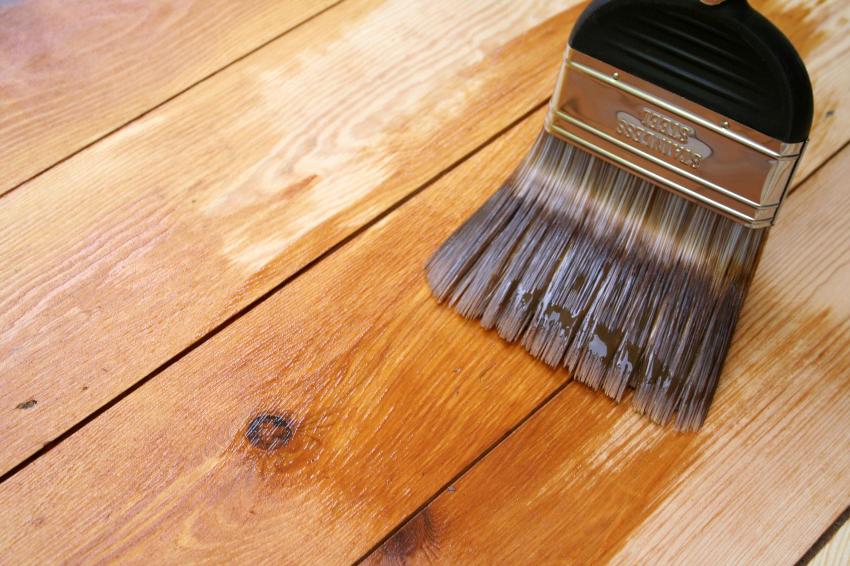
The medicinal formulations protect the wood from the growth of fungi, parasites, discoloration, exposure to sunlight, etc.
These are only the main advantages of antiseptics, depending on the type of composition, the characteristics and the possibility of protective impregnations can vary.
Which is better to buy a wood preservative: classification of compositions
The existing types of protective impregnations can be classified according to the following criteria:
- By type of base - organic, aqueous, oil and combined type solutions.
- By field of application - means for indoor and outdoor work.
- By appointment - preventive and therapeutic impregnations.
- By functionality - formulations designed to perform specific tasks, for example, for bleaching, eliminating parasites, protecting material from fire, etc.
- By the method of application - solutions that are applied superficially or deeply by dipping wood into the composition.
To choose a suitable composition, you must take into account all the above nuances. Otherwise, the impregnation will not bring the expected result.
Advantages and disadvantages of water based wood preservatives for outdoor use
Water-based antiseptics are used to protect all types of wood. Such materials usually contain:
- boric acid;
- sodium fluoride;
- borax;
- sodium silicofluoride.
In small quantities, these components are used to treat the finishes and interior and exterior elements of wooden buildings. More concentrated formulations are designed to protect parts buried in the soil, such as planks or piles.
Benefits of water-based products:
- Compared to non-aqueous impregnations, these compounds are less toxic. The most dangerous component of an antiseptic is copper sulfate, which can cause severe poisoning if accidentally swallowed.
- Safe and easy cooking process. Heating the composition over a fire in terms of the degree of danger can be compared with the usual making of a fire.
- No difficulties during transportation.
Disadvantages of water-based antiseptics:
- Unlike oil mixtures, water-based antiseptics cannot provide a high level of protection.
- The impregnation is easily washed off with water.
- To consolidate the protective effect, additional processing with insulating agents is required.
Important! Aqueous formulations can only be used to protect surfaces that will not be constantly exposed to moisture.
Properties of non-washable wood preservatives: advantages and disadvantages of oil mixtures
Oil-based antiseptics are in high demand among consumers, since they can not only protect wood from the effects of high humidity, but also prevent its penetration into the material.
This type of protective agent does not dissolve in water because oils are used to create it:
- anthracene;
- shale;
- coal.
They give the treated wood a rich, dark color. Since these compounds have a strong, unpleasant odor, they are used to protect the external elements of the building. Oil-based antiseptics are suitable for wood buried in the soil. There are mixtures with a more gentle effect. They are used to protect interior decoration, as well as gazebos and houses from the outside.
Advantages of oil compositions and mixtures based on bitumen:
- a mixture of heavy petroleum products with a viscous consistency forms a coating on the surface that protects the wood from oxygen and moisture penetration;
- the compositions are able not only to stop the growth of fungi and bacteria, but also to destroy the colonies already living in the wood;
- Waste oil and bitumen are not a favorable environment for the life of wood-boring insects, which need rotten wood and the absence of hydrocarbons and resins that are harmful to these organisms.
Wood processed with heavy oil products, even while in the ground, does not deteriorate for years.
Disadvantages of leave-in mixes:
- the components of the composition are toxic;
- if the manufacturing technology is violated, the antiseptic can ignite;
- stains on clothes cannot be removed;
- unpleasant specific odor;
- it is not allowed to be used for the treatment of internal premises due to toxicity.
Note! Oil products are not fire retardants and do not provide protection against fire.
Organic and combined wood preservatives for outdoor use
In most cases, organic antiseptics are used to protect facade surfaces. They form a thin film on wood, so they are most often used before painting walls. This base prevents moisture penetration into the wood, and also increases the adhesive properties of the paint and varnish material.
Related article:
DIY wood brushing: how to artificially age a tree
The essence of the aging process, selection of brushes and tools, do-it-yourself wood processing technology, application in the interior.
Organic antiseptics can also be used to protect interior wood surfaces. For this reason, they are widely used for pretreating logs or beams from which walls will be created.
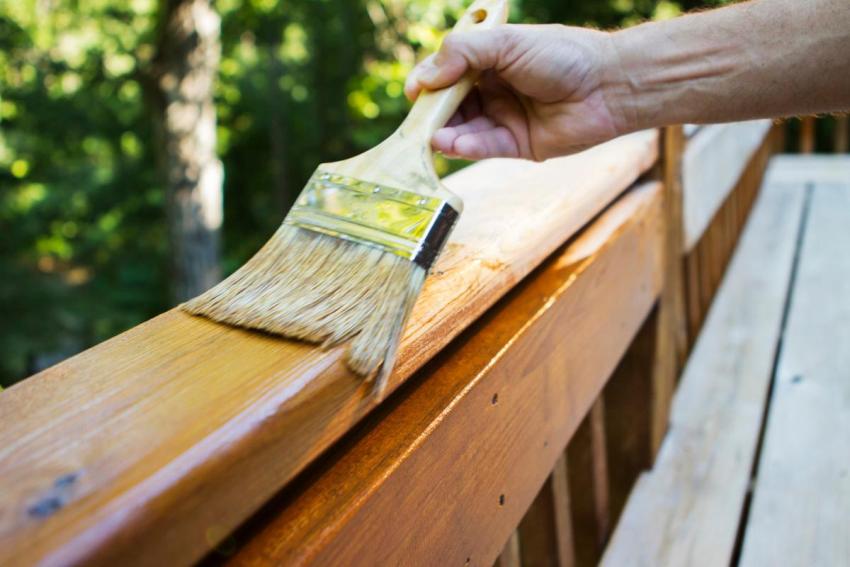
Organic antiseptics are used to treat facades, fences, benches and other wooden elements on the site.
After treatment with an organic antiseptic, the wood acquires a greenish tint, the porosity of its structure increases. In contact with metal parts, the compounds activate corrosive processes, therefore it is recommended to use additional protection in those areas that come into contact with the metal ..
The category of solutions intended for external work includes antiseptics used for the preparation and decoration of wooden surfaces. They are able to withstand the negative influence of aggressive environmental factors.
These criteria include:
- ultraviolet radiation;
- high level of humidity;
- exposure to low temperatures;
- sudden changes in temperature.
It is strictly forbidden to use products intended for outdoor use on internal wooden surfaces.
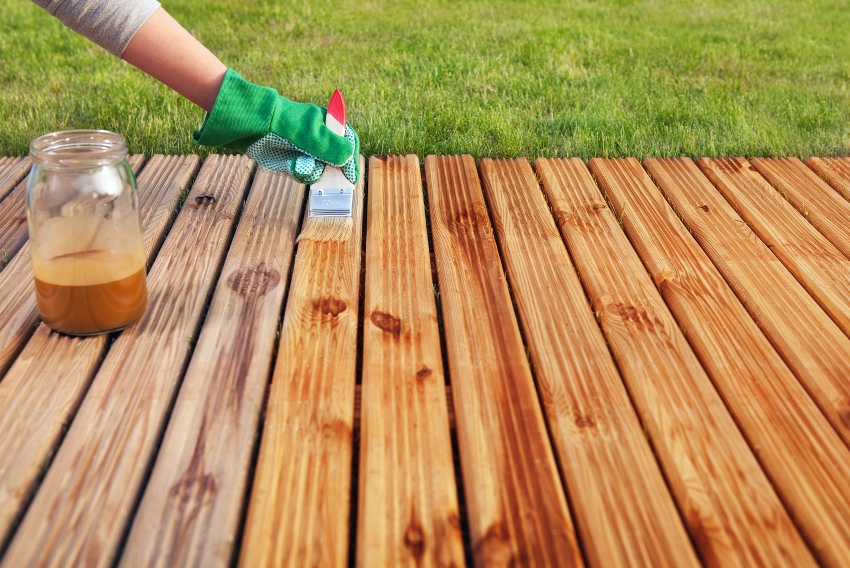
The solution protects wooden structures from moisture and precipitation, temperature changes and insects
Characteristics of wood preservatives for interior use
For the production of antiseptics for internal work, environmentally friendly raw materials are used.Such formulations do not have unpleasant odors and do not emit toxic substances into the air.
Note! When choosing an antiseptic for interior work, you should take into account the operational characteristics of the room in which it will be used. For rooms with different levels of humidity, certain compositions are selected. The information you need can be found on the packaging.
Combined type products have excellent performance characteristics. They are capable of providing a high level of protection against mold, parasitic microorganisms and fungi. Such compositions include components that reduce the flammability of the material, therefore the combined solutions belong not only to the category of antiseptics, but also fire retardants.
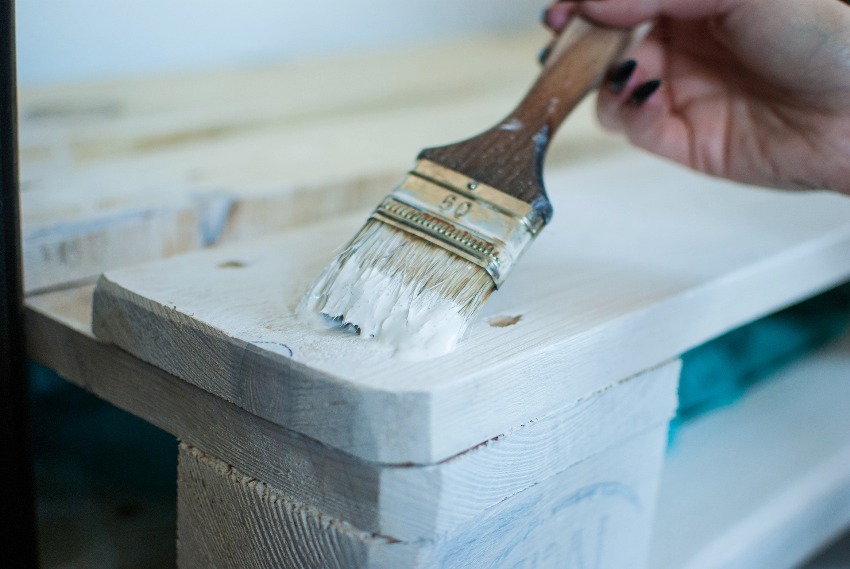
To choose an antiseptic for internal work, it is necessary to choose formulations that are safe for the human body
Features of therapeutic and prophylactic antiseptics
Healing solutions are used in cases where the wood is already infected with mold, fungal spores, insects and putrefactive processes occur in it. However, this type of antiseptic can also be used for preventive purposes. This is especially true in those cases when the operation of wooden structures in an aggressive environment is expected. Such conditions are found in rooms with a high level of humidity, for example, bathrooms, showers, rooms in a bath.
It is allowed to use medicinal compositions to prevent negative phenomena and protect building facades.
Prophylactic solutions are more widespread than medicinal solutions. They are used for the pre-treatment of lumber before the construction of a building or in its process. Experts recommend applying prophylactic impregnations to wood immediately after purchasing it.
Specificity of deep penetration wood preservatives and surface formulations
According to the method of application, antiseptics are divided into two types. Processing with the help of some solutions is carried out superficially (for this, a hydraulic control unit or a brush is used), others are able to penetrate deep into the material (for this, the wood is completely dipped into the composition, which can be cold or hot).
The choice of application method depends on what type of wood is to be treated and what part of it will be affected. For example, ripe heartwood of conifers is rather difficult to impregnate under normal conditions, but it is perfectly processed when the antiseptic is heated to 95-100 ° C.
The main methods of applying an antiseptic are:
| Deep | Superficial |
| Dipping in hot and cold baths | Dry capillary treatment |
| Autoclaving under high pressure | Immersion in a heated antiseptic solution (composition in a warm state) |
| Autoclaving using vacuum | Application of the product with a spray gun, brush or roller |
| Bandage method | Antiseptic application by diffusion method |
| Combined method |
Useful advice! Water-soluble mixtures easily impregnate raw wood, penetrating deep inside. However, like organic solutions, it is desirable to use them for processing dry wood, although in some cases the composition will be difficult to distribute over the surface. The sapwood of beech, pine and birch is most easily impregnated.
Which is better to choose a wood preservative: the functional purpose of the compositions
Existing antiseptics are divided into categories based on their functional effect on wood. There are many factors that can cause biological contamination of the material.
The most common ones are:
- untimely processing of wood with antiseptic agents;
- lack of a good ventilation system;
- violation of the rules for storing lumber;
- contact of a wooden surface with moisture;
- poor quality insulation, etc.
Many antiseptics have a targeted effect. They can restore the wood to its normal natural color or increase the fire resistance of the material.
Protective antiseptics for wood bleaching
Whitening antiseptics not only protect the material from negative external influences, but also restore the natural color of wood that is infected with parasites or is simply aged. The most popular in this category are the compositions "Bioshchit", which also have a healing effect.
Impregnations "BioShield 2" and "BioShield 1" prevent the development of putrefactive processes, which are the result of the activity of pathogenic microflora. In addition, these antiseptics preserve the technical characteristics and physical properties of the material, as well as restore the healthy color of wood that has not been stained.
The capabilities of the "BioShield 1" antiseptic will be quite enough if the damage to the material is in the initial stage. After the treated surface is completely dry, it can be decorated or painted. If the wood is strongly affected by fungi and mold, it is better to use "BioShield 2". Both of these products are ideal for treating lumber used in log houses and saunas.
No less popular are the whitening antiseptic products of the manufacturer "Sagus" - solutions "Standard", "Profi" and "Light". These impregnations are water based. They are intended for deep removal of damage from unpainted material, which are the result of the activity of wood-coloring saprophytes or black mold. The compositions are used to process timber and logs, on the basis of which baths and houses are built.
Antiseptic "Standard" quickly and deeply penetrates into wood fibers. It is used when the first signs of moss, mold and lichens appear. It is allowed to use this solution if the material has darkened under the influence of UV rays. Antiseptic "Profi" can eliminate the consequences of severe damage to wood.
Useful advice! The "Profi" solution can be effectively used for processing not only wood, but also other building materials of mineral origin, for example, gas silicate blocks or bricks.
Whitening agent "Light" is suitable for lightening material that has darkened under the influence of ultraviolet radiation or damaged by mold. This composition is distinguished by its mild action, due to which it retains the natural properties of the wood structure.
Whitening antiseptic concentrates for wood: Neomid and Prosept
The concentrated preparation "Prosept 50" is an antiseptic agent with a whitening and therapeutic effect. The composition actively fights against foci of biological damage, restoring the natural color of the wood and removing gray plaque within half an hour after application. At the same time, the natural structure of the material is preserved.
The agent penetrates the material to a depth of 3 mm. 12 hours after application, the wooden surface can be painted, insulated or wallpaper can be glued. Antiseptic "Prosept 50" has an environmentally friendly composition, so it can be used not only for external, but also for internal processing. It is allowed to use the solution to protect wooden pallets intended for storage and transportation of food.
In order to fix the solution deep in the structure of the material for a long time, it is desirable to treat the surface with an antiseptic that has a preservative effect. For these purposes "Neomid 440 Eco" and "Neomid 430 Eco" are suitable. These formulations prevent the recurrence of lesions.
Protective antiseptics against mold and other parasites
Wood is a breeding ground for mold and mildew. Moreover, the risks increase if the material is constantly in contact with a humid environment. When parasitic microflora and fauna settle in wood fibers, it is extremely difficult to get rid of it. To prevent the process of damage to the material, it is necessary to use a special antiseptic composition, which will prevent the appearance of fungi or stop their development.
Solutions of this category are also used to repel insects that harm wood and, in the course of their life, process it into dust. It should be noted that in nature there are many varieties of parasitic wood beetles. However, with the timely implementation of preventive procedures, all the risks associated with them can be nullified.
Useful advice! If large areas are affected by microorganisms, it is advisable to use antiseptic agents after medical procedures using fungicidal agents.
Antiseptics against parasitic microflora and fauna: PAF-LST and Senezh-BIO
The manufacturer “Senezh” supplies the market with a large number of compounds intended for the protective treatment of wood. In the assortment, you can pick up tools for any details of the building. The Senezh Bio solution is very popular. It reinforces the natural protective properties of wood. This composition is water-based, due to which it impregnates the material well. As a result of processing, a three-level threshold with protective properties is formed. "Senezh Bio" is suitable for processing interior and exterior surfaces.
In addition to solutions that increase the resistance of the material to mold and wood beetles, this manufacturer produces compounds that protect wood from the effects of moisture, ultraviolet radiation and fire.
To protect wood, the PAF-LST antiseptic paste can be used. It is water-soluble, made on the basis of lignosulfate and fluorine. According to the manufacturer, this antiseptic can extend the life of the material up to 30 years.
The paste is used for processing wood, which is used for the construction of structures for enclosing and supporting purposes. The product can even be applied to raw material. This antiseptic is odorless. After processing, the wood acquires a dark pistachio hue, and a rough protective layer forms on its surface. This composition is used in cases where no further staining of the wood is expected.
Remedies for parasitic microflora and fauna: antiseptics for Tikkurila and Belinka trees
The Slovenian manufacturer Belinka is in high demand on the domestic market. This company is engaged in the production of protective and varnish-and-paint compositions for surfaces made from various raw materials.
The manufacturer offers several products designed for biological wood protection:
- "Base";
- "Impregnant";
- "Belocid";
- "Belbor fix concentrate".
The products of the Finnish manufacturer Tikkurila, which are distinguished by their high reliability and quality, are no less popular.This company produces several varieties of antiseptics in the form of water-soluble tablets and liquid formulations.
Protective agent "Homeenpoisto +" is a tablet, on the basis of which a solution is prepared, designed to eliminate foci of mold, as well as preventive treatment.
Ready-made solution is used to protect:
- new and old sawn timber;
- internal and external surfaces;
- parts made of wood and materials of mineral origin.
Note! The surface is treated with Homeenpoisto + immediately before painting.
To prepare an antiseptic solution, you must dissolve the tablets in water in accordance with the manufacturer's instructions. Then the composition is applied to the surface using a spray gun. After this, a short break is made to give the agent the time it takes to affect the affected areas. Next, you need to treat the surface with a foam sponge or brush, rinse it with clean water and dry it. When the wood is completely dry, it should be painted immediately.
There is another antiseptic in the Tikkurila line - "Homeenpoisto 1". It has a jelly-like consistency and is used to prevent and protect wood from lesions. The composition contains a component such as hypochlorite, so it cannot be used for internal treatment of premises.
Wood preservative for fire protection: the main types of fire retardants
Wood belongs to the category of highly flammable materials, so it needs special treatment with protective agents that increase its resistance to fire. Antiseptics designed for these purposes are called fire retardants.
They come in different forms:
- Impregnations are water-based solutions that are characterized by a deep degree of penetration.
- Varnishing compositions - form a thin protective film on the treated surface. It is transparent and protects the material not only from fire, but also from rapid heating.
- Enamel coatings and paints are used to protect wood, as well as its subsequent decoration.
- Paste-like coating materials - protect the surface from exposure to open fire, not intended for decoration.
- Powders - application is carried out by spraying using special equipment.
Flame retardants are used for both deep and surface treatment. On sale you can find compositions intended for outdoor and indoor use.
Useful advice! To protect the facade of the building from fire, it is advisable to use solutions with weather-resistant properties. For internal processing, environmentally friendly compounds are required that are resistant to the effects of an aggressive environment (this requirement is especially important for bathrooms and bath rooms).
Fire retardants are passive or active. The active principle of action is possessed by substances that emit non-combustible gases during heating. They restrict the access of oxygen to the fire, preventing its spread.
Passive fire retardants include compounds that, during heating, form a protective layer on the surface that protects the structure of the material from fire. Such solutions melt under the influence of high temperature, forming a non-combustible coating in the form of a crust. This process requires a significant expenditure of thermal energy, as a result of which the degree of thermal resistance of a structure made of wood increases.
Means of biological fire protection: antiseptics for the tree Neomid, Senezh and Pirilax
For complex protection against biological effects and fire, the compositions "Ognebio Prof" and "Senezh Ognebio" from the manufacturer "Senezh" can be used. These solutions are used to treat building walls from the outside as a preparatory measure before painting. If the protective layer formed on the surface by these preparations is left without a topcoat, all useful substances will disappear very quickly.
Fire retardant solution of the Pirilaks trademark has a universal purpose. It can be used for indoor and outdoor use. This composition provides surface protection against parasites:
- mold;
- wood-coloring saprophytes;
- wood beetles.
In addition, Pirilax increases the resistance of wood to the effects of open fire, extends its service life, reduces the likelihood of cracks, and also slows down the aging process. The solution is excellently combined with other paints and varnishes. The manufacturer claims that after processing, the wood will be protected from fire for 16 years, and the biological resistance period is 20 years. The composition is environmentally friendly, it is completely safe for the environment, does not harm human health.
With regard to fire-biological protection, solutions such as "Neomid 450-1" and "Neomid 450" are very effective. They are designed for the treatment of external and internal surfaces. Application is carried out after preliminary mechanical cleaning. It is not allowed to use drugs on surfaces that are painted or impregnated with compounds that form a film coating.
Useful advice! If wood is affected by saprophytes, soak it with a bleaching antiseptic before using a fire retardant.
Which is better to use: tinting or glazing wood preservatives
After treatment with an antiseptic, even transparent, the wood changes its color. Therefore, many resort to intentional coloring of the surface so that it can subsequently fit optimally into the exterior of the building or the interior of the room. One of the most popular manufacturers, Tikkurila, offers consumers biocidal antiseptic agents that penetrate deep into the wood and form a colorless coating on its surface.
Glazing compounds need additional protection, otherwise they will be washed out over time. For these purposes, special water-repellent preparations are used. If it is supposed to treat the surface with an antiseptic without subsequent staining, you can limit yourself to any tool. Telegraph poles, rail sleepers and other similar items do not need a topcoat.
In some cases, the presence of an antiseptic creates problems for further staining. In such situations, manufacturers offer to purchase a complex-purpose material, namely paints and varnishes with universal capabilities, including biosecurity. On the other hand, multipurpose mortars are not always able to provide the best result, especially when dealing with problematic and contaminated lumber.
In order to preserve the natural color of the tree as much as possible, it is advisable to use azure coatings. Such formulations can be found in the Illumina range. The company produces special azure preparations that are suitable for external and internal use. They are colorless and perfectly emphasize the natural wood pattern. For interior decoration can be used coatings "Lazur", manufactured under the brand name "Belinka".
As for tinting compositions, their use is also accompanied by certain advantages. These solutions prevent wood from burning out and also facilitate application and even distribution of the preservative.
Useful advice! To eliminate gaps during the application of the antiseptic, a dye intended for fabric can be added to its composition in a ratio of 50 g of pigment per 100 l of the preparation. It is advisable to dissolve it in advance in a small volume of water, and then carefully pour it into the protective solution.
UV protective agents: antiseptics for the Martyanov, Senezh and Biofa tree
Ultraviolet protection products include special additives and pigments. It is these components that reduce the damaging effects of sunlight.
Antiseptic "Martyanov" is a pigmented protective oil-based impregnation. It is used to protect the material from wood borers and all types of saprophytes. Provided that the requirements of the application technology are met, this solution lasts on average for about 8 years.
Thanks to the improved formula, the antiseptic effectively fights blue and mold. It features a simple application system while providing protection from precipitation, sun and cold temperatures. Suitable for buildings operating in harsh climatic conditions.
"Senezh Aquadecor" is another protective decorative solution with antiseptic properties. This antiseptic contains special additives that function as UV filters. These components protect the wood from darkening. The manufacturer offers a wide range of colors, so that the consumer can find a solution for processing internal and external surfaces of the required shade.
Antiseptic "Biofa 2108" contains the smallest particles of white pigment that protect wood from ultraviolet radiation. It can be applied to external and internal surfaces. At the same time, the natural color of the material practically does not change. The mortar is made using linseed oil, which deeply impregnates the wood and does not create a film coating on its surface. This antiseptic is environmentally friendly, does not emit harmful substances into the environment.
Note! If a pigmented antiseptic is used to protect the material, the coating should be renewed every 8-10 years. When using colorless solutions, wood is processed every 3-4 years.
Waterproof wood preservatives for outdoor use: Tikkurila and Pinotex
Elements of wooden structures that are in contact with the soil, as well as structures located in regions with an extremely humid climate, need protective treatment with special means.
For external surfaces, many consumers use the Valtti Aquacolor oil antiseptic. The manufacturer "Tikkurila" offers customers a wide range of colors. The antiseptic tinting palette includes 40 shades, which makes it possible to turn it into a multifunctional product with excellent decorative possibilities.
Means "Pinotex Terrace Oil" is a composition in the form of a tinting oil, which can be used for the treatment of structures located in the open air. Such structures include:
- open terraces;
- gazebos;
- benches, etc.
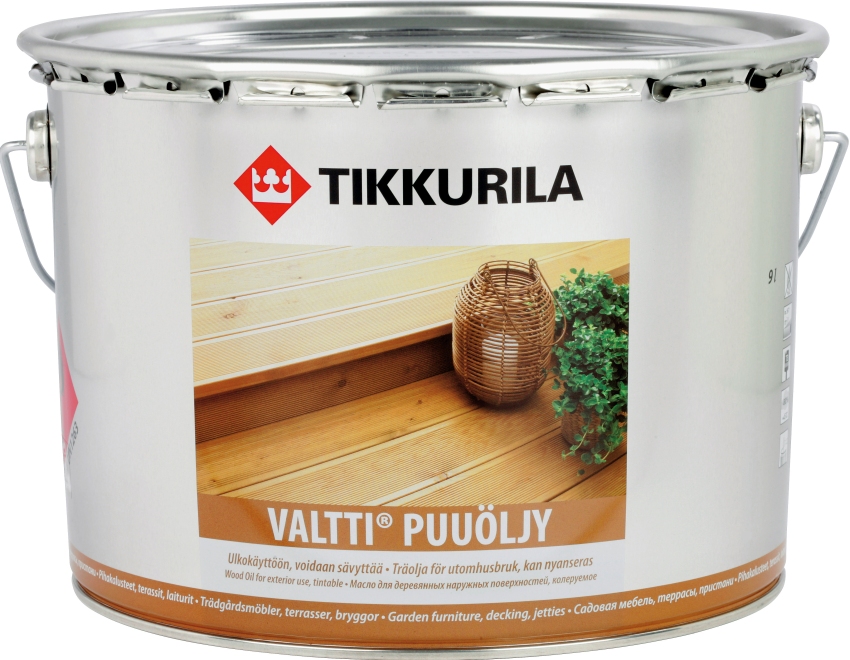
Antiseptic Tikkurila for external work is intended for the treatment of wooden arbors, fences, stairs and other structures
The impregnation contains components that protect wood from lichens, mold, algae and other parasitic flora. In addition, it contains a wax that repels moisture from the surface. It increases the resistance of wood to mechanical stress, and also makes it hydrophobic. The consumer is offered 39 shades for pigmentation of the composition.
Moisture protection products for baths and saunas: antiseptics for wood Senezh and KRASULA
There is a special category of formulations for use in saunas and bath rooms. These solutions must have special properties, including resistance to moisture, high temperatures and steam. Therefore, when choosing an antiseptic for such needs, you should pay attention to the specification that is indicated on the package.
Antiseptic "KRASULA" - a protective composition with decorative properties, used to treat wet and dry surfaces in baths and saunas.
The mechanism of action of this impregnation is as follows:
- protection of the surface from moisture and dirt (soap solution, grease, soot, sticking leaves);
- elimination of algae, mold and prevention of their reappearance;
- protection of wood from insects.
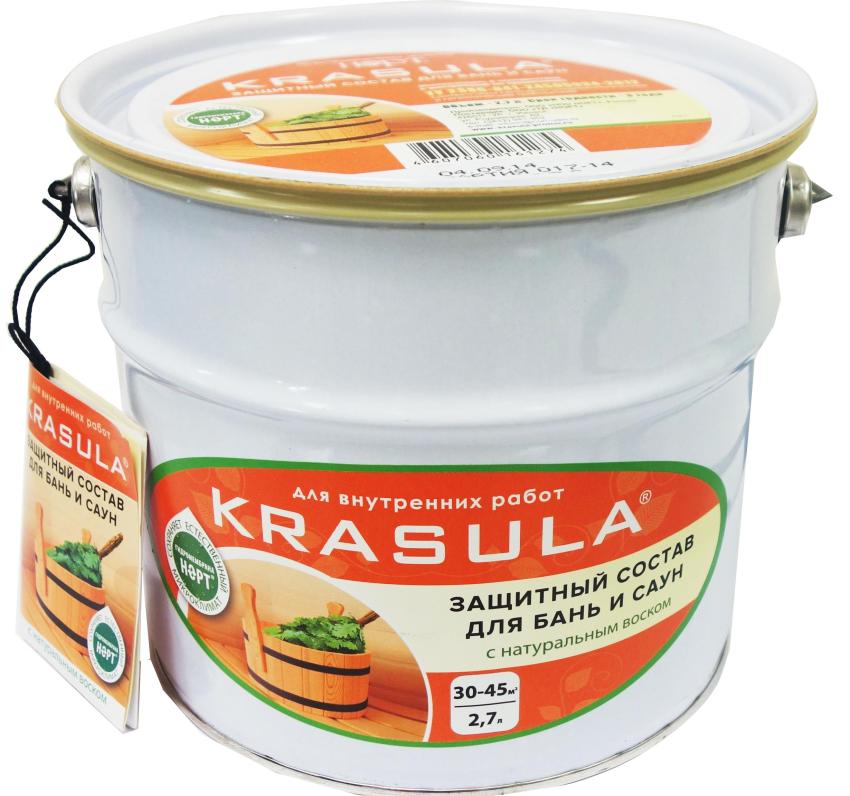
Krasula moisture-proof impregnation is intended for the treatment of wooden surfaces inside baths and saunas
The product reacts well to high temperatures, it is safe for humans. This antiseptic preserves not only the appearance of wood, but also its natural smell.
Note! The warranty period of the KRASULA antiseptic for rest rooms in saunas and baths is 7 years, for wooden surfaces in steam rooms and washing rooms - 5 years.
Means "Senezh Sauna" has an antimicrobial effect. This impregnation is made from environmentally friendly raw materials, therefore it does not emit toxic and harmful substances into the air. The antiseptic does not lend itself to washing out, while maintaining the structural integrity of the material. After processing, the wood becomes unattractive for parasitic and pathogenic microorganisms, even if it is constantly exposed to moisture.
The best antiseptics for wood with high levels of natural moisture
If for the construction of a building on the site, sawn timber was purchased that did not pass the preliminary preparation procedure, such wood must be treated with a protective agent before drying. The same goes for logs that are not barked. For this, it is advisable to use specialized formulations that will protect the wood while it is naturally drying.
Such funds are used during:
- transportation of lumber;
- storage during the drying period;
- building construction.
Solutions used to treat such wood are capable of deep penetration into the material, while the coating does not interfere with natural ventilation. Antiseptics recommended by specialists include:
- Senezh Insa;
- "Neomid 46";
- "Senezh Trans";
- "Prosept-46";
- "Neomid 420";
- "BS-13";
- "Prosept-42";
- Eurotrans.
All of them protect lumber from attack by fungi and insects.
Protective antiseptic for wood: which one is better to choose a composition for the end of the logs
The end part of boards, logs and beams needs enhanced protection, since the material in this zone has a porous structure. This structure allows moisture to more intensively penetrate into the wood, provoking the development of putrefactive processes in it. As a result of this effect, a favorable environment for the growth of mold is created.
In addition, the contact of the end zone with moisture leads to the appearance of deep cracks, which reduce the strength characteristics of the wood. To prevent this, it is advisable to use protective equipment that can be applied not only during the preparation of lumber for construction, but also on the timber and logs of an already finished building.
For these purposes, the Senezh Tor antiseptic is perfect. It has all the necessary characteristics and capabilities to effectively protect vulnerable parts of wood. The solution is suitable for processing new sawn timber, as well as objects that have already been put into operation.
Note! The coating needs to be renewed every 3-4 years.
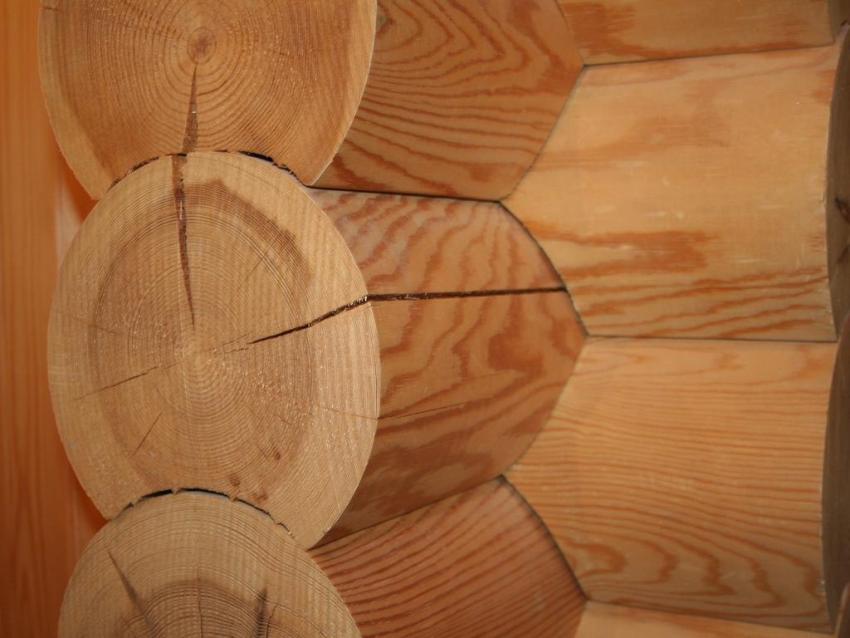
The porous structure of the end part of the logs needs special protection from parasites and prevention of cracks
Choosing a high-quality antiseptic for wood: reviews, prices and recommendations
When choosing an antiseptic, one should take into account not only its functionality and purpose, but also other factors that will help identify a quality drug.
When choosing a protective solution for wood, you must pay attention to the following points:
- manufacturer;
- guaranteed validity period;
- the economy of the antiseptic;
- versatility.
An antiseptic must meet all quality criteria, be environmentally friendly, effective and safe, and also be manufactured using high-tech equipment. All these conditions can be provided only by large manufacturers with the required profile. When choosing a protective solution, it is advisable to study in detail the information on the packaging, as well as familiarize yourself with consumer reviews on the network.
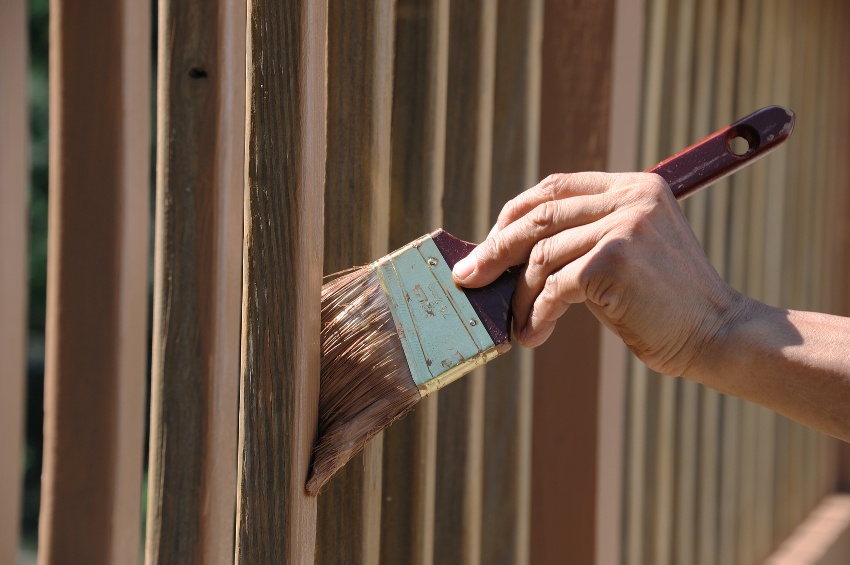
When choosing an antiseptic, it is necessary to take into account its intended purpose, manufacturer, characteristics and user reviews
Depending on the quality, the antiseptic can provide the required level of protection for 2-7 years. At the end of this period, you will have to renew the coverage. If the manufacturer claims that the period of validity of his products is 20-40 years, then you should not blindly believe such information. Under the influence of external factors, even the highest quality antiseptics gradually lose their beneficial properties.
Many buyers seek to save money on the purchase of a protective product by paying attention to low cost antiseptics. However, this approach may be wrong. Some formulations have such a high consumption that in the end the costs of treating wood surfaces may be too high. The average consumption rate for most impregnations is 200-250 g / m². For fire retardants, this parameter is 400-600 g / m².
Average rates and reviews: antiseptics Senezh, Tikkurila and Neomid
To decide on the choice of a wood preservative, it is enough to read the opinion of experts and consumer reviews, which can be found on the Internet.
The following trade marks have been awarded the high quality mark:
- Tikkurila;
- Senezh;
- Sodolin;
- Valtti;
- Neomid, etc.
Note! The reputation of the manufacturer is of no small importance. Nevertheless, in each category of protective equipment there are antiseptics that effectively solve certain problems. Therefore, the choice of the composition should be approached individually.
According to customer reviews, Homeenpoisto 1 solution from the Tikkurila trademark and PAF-LST paste are best suited for protection against saprophytes. The average price of antiseptics for wood of this level is 110 rubles / liter. In addition, users often share their experience of using waste oil and copper sulfate for the same purposes.
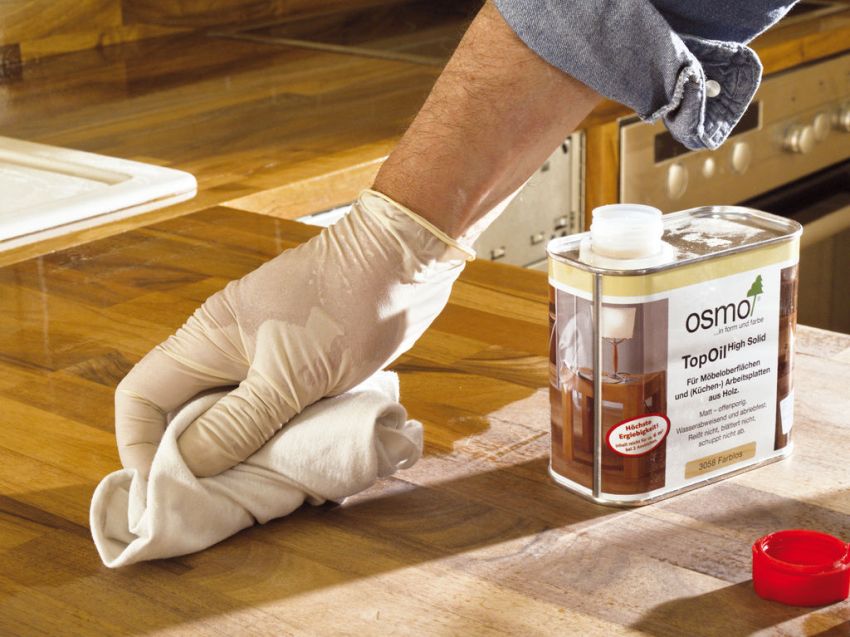
It is not recommended to use impregnation intended for external work for the treatment of internal surfaces.
The largest number of positive reviews in the category of bioprotective solutions for wood in contact with a humid environment received antiseptics of domestic production "Senezh Bio" and "Senezh Ultra". The compositions "Valtti Aquacolor" and "Neomid 440" performed well. These impregnations are applied in 2-3 layers on a thoroughly cleaned and dried surface. Manufacturers produce protective compounds in containers with a volume of 0.5-50 liters at a cost of 70 rubles / liter.
For processing materials with a high level of natural moisture, buyers recommend using the following products in their reviews:
- "Neomid 460";
- "Senezh Trans";
- Finesta;
- Senezh Eurotrans;
- "BS-13".
The size of the containers varies from 10 to 200 liters. The average price of solutions is 25 rubles / l.
In the rating of the best antiseptics for unbarked wood, the top position is occupied by the impregnation "Neomid 420". Its price is 100 rubles / liter. For these purposes, folk remedies are also used, for example, oil or bleach in combination with quicklime. Of course, it is preferable to use proven specialized formulations.
If it is supposed to paint or open a wooden surface with varnish after applying an antiseptic, users agree that it is best to use such solutions:
- Valtti Pohjuste;
- Pinotex Wood primer;
- Valtti Aquabase;
- Pinotex Base.
The lower price limit for these compounds starts from 110 rubles / liter.
How to make a wood preservative: impregnating the material with a protective agent
Do-it-yourself compositions at home are much cheaper than factory antiseptics. The procedure for creating them is quite simple, the main thing here is to adhere to security requirements. In the process of work, you should definitely use gloves and a protective mask, because a large number of various substances will be needed to prepare an antiseptic. The composition of the impregnation is selected taking into account the purposes for which it will be used, as well as the method of application.
Important! Care should be taken when applying the antiseptic. This is especially true of the time of harvesting from the site: if substances get on the fruits, you can get poisoning.
How to prepare a bituminous wood preservative with your own hands
In the composition of such an antiseptic, not only bitumen is present, but also thinning substances, for example, gasoline or diesel fuel. If diesel fuel is added to the solution, the solidification process will be long, which will increase the depth of the protective layer. Conversely, using gasoline will speed up the drying time. This feature of the antiseptic is useful if there is little time allotted for the preparatory work.
Bitumen thinners can be purchased at any gas station. The used oil is sold at service stations. Construction shops sell bitumen. In addition to these components, work will require a container where the bitumen will be heated, devices in the form of stops for fixing the container over the fire source, as well as a stirring device (necessarily metal).
The preparation of a bituminous antiseptic is carried out in the following order:
- Bitumen is poured into a heating container and installed over a source of open fire. It could be a fire or a burner.
- After firing up, heating gradually increases.
- Bitumen heats up until it is completely liquefied. To avoid the formation of lumps, the substance is periodically stirred.
- When the bitumen acquires a slightly viscous consistency, the fire should be extinguished, and the container with the substance should be removed to the side.
- A solvent is added to the container with bitumen. This must be done carefully, in small portions, so that the mixture does not splash under the influence of temperature.
Useful advice! If it gets into the heated bitumen, gasoline will evaporate intensively, so you need to wait until the mixture has cooled slightly before adding it.
The proportions of the components will depend on the initial condition of the base (bitumen). When properly prepared, the mixture will have a liquid consistency at room temperature. The amount of gasoline or diesel fuel in the finished solution should not exceed 20-30%.
If the bitumen is heated too quickly, the mixture may foam and overflow the container. This will indicate the presence of water in the composition of the substance. To avoid such consequences, it is recommended to carry out a slow heating, due to which the water will gradually evaporate. The composition is used immediately after cooling.
Preparation of a water-based impregnation and wood treatment with an antiseptic
To prepare a water-based salt impregnation, you will need to dissolve a certain amount of salt in heated water. The fact is that an increase in the temperature of the liquid will contribute to the complete and rapid dissolution of crystals. There are several recipes with different ratios of sodium fluoride and copper or ferrous sulfate.
A weak sodium solution is sufficient to protect wooden surfaces in domestic buildings. Its share in the finished mixture can be 0.5-4%. This means that 10 liters of water will contain 50-400 g of salt. This indicator is selected taking into account the operating conditions. For internal processing of wood, you can limit yourself to using mixtures with a minimum concentration. Outdoor structures such as benches and gazebos need more protection. This will require a rich composition.
Useful advice! To control the quality of the application, 10 g of potassium permanganate can be added to the finished solution. Do not be afraid of the intense color: after a while it will wash out from the surface.
It is advisable to use a wide brush or spray for application. To protect wooden pillars and structural elements buried in the soil, it is better to take sulfate compositions, where the proportion of the content of the main component does not exceed 10-20% (100-200 g per 1 liter of liquid). To enhance the effect of such antiseptics, it is recommended to thoroughly dry the material and soak it for a long time.
The vitriol solution has a specific saturated color, so there should be no problems with the quality of application. Those areas of wood that will come into contact with the soil during operation must be well soaked in a ready-made antiseptic.
To prepare a water-based composition, it is enough to have a container with you, a fire source for heating the liquid, as well as a stirrer, for example, a spatula. The solution is applied to the surface immediately after cooling.
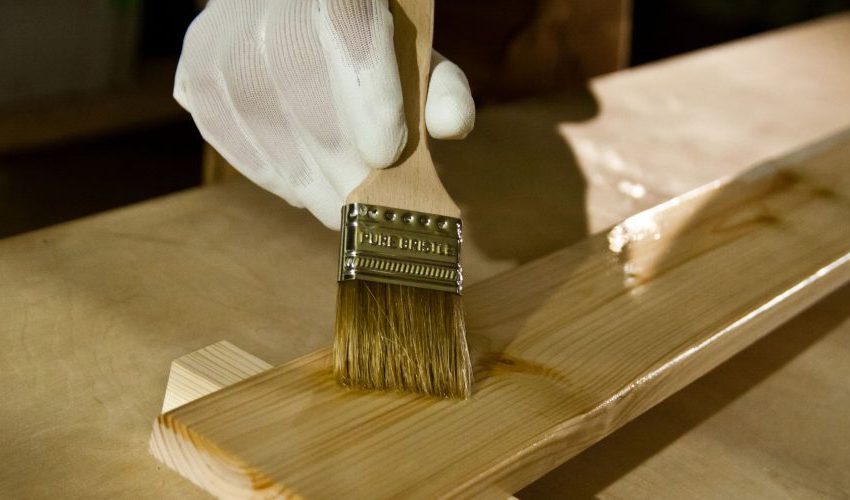
Depending on the composition, the impregnation can penetrate deep into the structure of the tree, or form a protective film on the surface.
In general, the process of preparing antiseptics is not difficult. In order to exclude errors in the preparation of dosages, it is advisable to study the characteristics and properties of the wood that will be processed. The same applies to the choice of factory-made impregnations. Having correctly evaluated the condition of the material with which you have to work, you can choose a really effective and reliable solution and ensure the protection of wooden structures for many years.
